An array is an operation in T-FLEX CAD for creating copies of already existing 3D objects.
The placement of created copies (array elements) depends on the array class: linear, circular, array by points, array by path, parametric array. Array elements can be positioned along the direction vector, at the specified step (linear array), on a circle about the specified axis (circular array), along a path (array by path), at the specified 3D points (array by points) or following the prescribed parametric law (parametric array).
The source objects for creating an array (copy objects) can be selected among 3D construction elements, operations, Bodies and faces. The set of objects replicated in the array can contain several elements, however, of the same type.
The arrays are divided into the following types, depending on the type of the objects to copy: arrays of construction elements, arrays of operations, arrays of Bodies and arrays of faces. All arrays of the same class share in creation and editing techniques, regardless of the array type.
The copies resulting from any array except array of Bodies can be used in subsequent operations. The result produced by an array of Bodies can only be used for creating another array.
Array types. Specifics of each type
All arrays are distinguished by the types of the copy elements as follows:
● Arrays of construction elements;
● Arrays of operations;
● Arrays of Bodies;
● Arrays of faces.
Creation of any array begins from selecting its type.
Array of construction elements
An array of construction elements allows creating a special type of 3D elements – an array of 3D constructions. Arbitrary 3D construction objects can be selected as the objects to be arrayed, except sections, light sources and cameras. Those could be 3D nodes, 3D paths, 3D profiles, workplanes, etc. The same array can combine construction objects of different types, such as, for example, 3D profiles and 3D paths.
When creating an array of workplanes of any class, 2D drawing pages of the type "Workplanes" are automatically created for each array element.
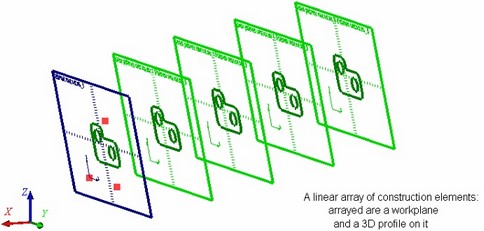
The source construction elements are not included in the array. A "blank" is created in place of the source element (elements) in the array. However, an additional copy can be included in the array, coinciding with the position of the source element.
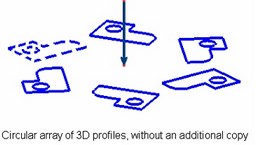
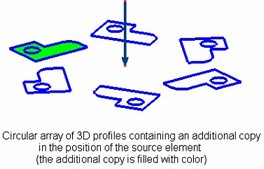
Array of Bodies and array of operations
Arrays of Bodies and arrays of operations create copies of bodies already existing in the scene. The source object for arrays of these types is an operation.
An array of operations copies results of a particular operation only. If another operation is created on top of that one, such as, for example, blending an edge, the array will not be affected. On the other hand, an array of Bodies replicates the whole Body, created by using the selected operation. If this Body is modified in the future, the array will be regenerated, accounting for new operations included in the Body history.
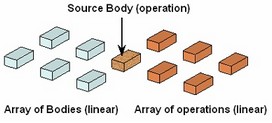
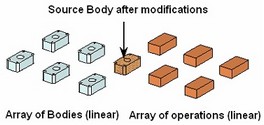
When an array of Bodies is built, a new 3D Body is created which is actually the array. The source Body (Bodies) is not included in the array (its place in the array is filled by a "blank").
An array of operations requires a specific setting regarding whether or not to include the source operation in the array composition. If the source operation is included in the array, it will be subjected to all parameters defined for this array, such as the material, system-wide parameters (level, layer, color), transformation parameters, etc. Besides, if the operation selected for array creation is the last operation in the history of a Body, then this Body disappears upon the array creation, being replaced by the array.
In the cases, when the source operation is not included in the composition of the array, then the operation itself and the Body that it creates will remain independent objects of the 3D model. The array in this case will have a "blank" in the position corresponding to the source operation location (just like in the case of creating a construction array).
The following additional manipulations can be applied when creating any Body arrays and operation arrays:
● Separate to Solids – the created array is automatically divided into separate Body copies;
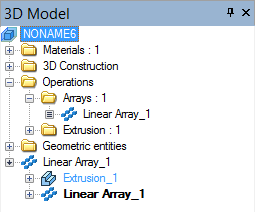
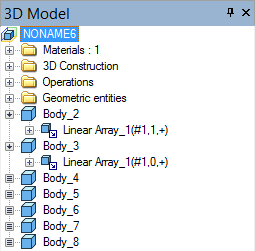
● Combine Result to one Solid – all array elements are merged together by the Boolean addition.

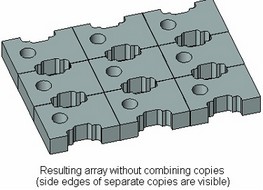
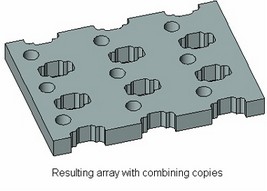
Array of faces
The main purpose of any array of faces is to add holes and protrusions to the existing Bodies of the 3D model, repeating design features already present in the given Body. Therefore, an array of faces is always created based on one particular Body in the model: all copied faces must belong to that Body. The set of copy faces resulting from the array creation will also be included into the source Body.
No array of faces creates a new 3D Body; rather, the existing one is altered by the array.
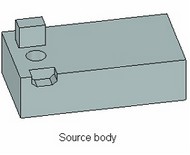
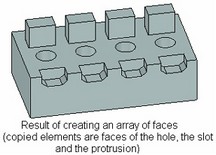
An arbitrary set of faces can be selected for creating an array, except that it has to fully define the geometry of the hole, slot or protrusion of the part being copied. The copies must be created within the bounds of the source body.
Creation of an array of faces may not affect the topology of the source body. Therefore, arrays should be created in such a way, that the copies of the faces intersected with the faces of the source body in the same way as the faces of the source set.
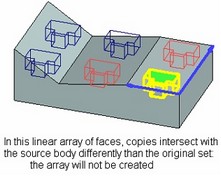
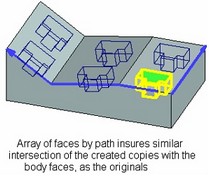
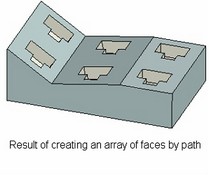
When specifying the set to array, you can select:
● Edges surrounding a set of faces. A set of edges defines two possible sets of faces (we will call them the "inner" and "outer" sets with respect to the specified chain of edges). The system can automatically select the set to copy (judging by the least area) or let the user choose.

The selected edges must make one or several close sequences (loops).
● All faces to be included in the source set of the array;
● The operation that created the desired set of faces (for example, the operation "Hole"). In this case, the array will keep a link to the selected operation. If in the future the geometry of such operation will change, the 3D array will regenerate accounting for the changes.
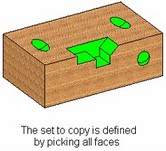
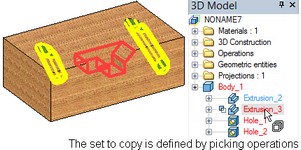
The following optional modes can affect the resulting array of faces:
● Copy to one face. Use of this mode considerably reduces the array regeneration time. However, this mode can only be used when all elements of the array being created lie on the same face as the source set;
● Extend Faces (used only in combination with the "Copy to one face" mode). This mode allows lifting up the requirement of "similar intersection" of the source set of faces and all arrayed copies with the faces of the source body. The system will be automatically extending or trimming the copied faces in order to insure their correct connection to the body.
Use of this mode is possible only in the case when all copies are located within the range of the same body faces, as the source set.
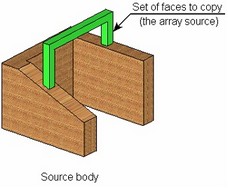
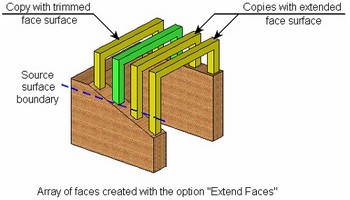
● Check Intersection with other Faces (used to avoid body self-intersections). When using this mode, the system checks face copies for intersections with already existing body faces. If such an intersection is encountered, then array creation is aborted.
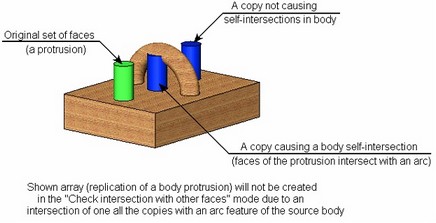
●Do not check boundaries of body (enabled by default). When using this mode, the check of correctness of the resulting array is carried out once after creation of all copies. In this case the system checks the resulting copies only by the following criterion: they must lie within the limits of at least one of the faces of the body. This check does not entirely exclude the occurrence of errors in cases when the faces-copies lie on the boundaries of faces but nevertheless decreases, by several times, the time required for construction of a big array.
When the “Do not check boundaries of body” mode is disabled, the system, before the start of copying, checks whether the result of copying is located beyond the boundaries of all faces of the body. If yes, such faces-copies will simply not be created. The second stage of the check is carried out after copying – the created faces-copies will be checked for intersection with the boundaries of that face of the body onto which they were copied. If the intersection was detected for a copy, this copy is removed from the array. This work mode guarantees better safety of array construction mechanism but significantly increases the time of array construction.